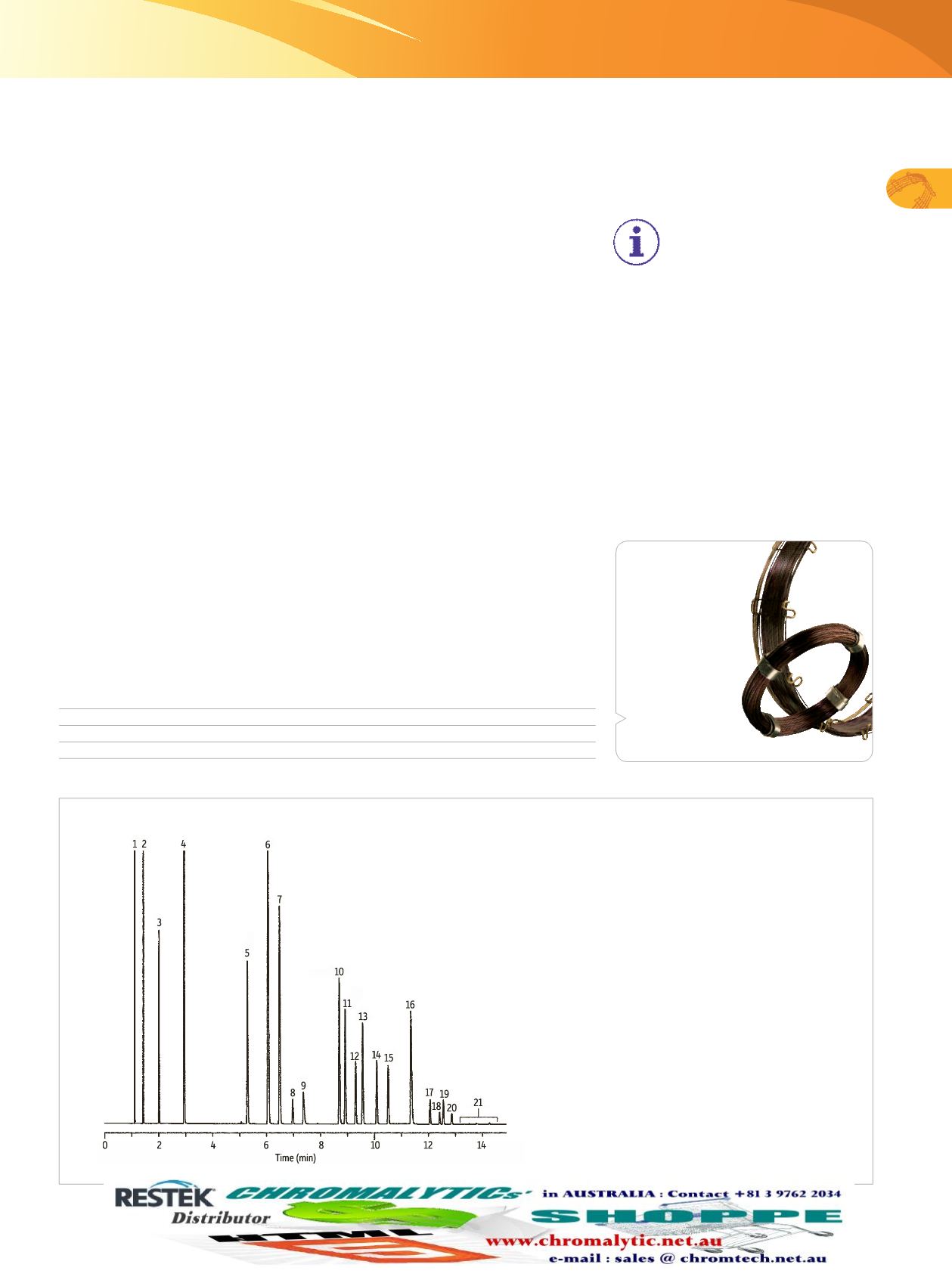
 www.restek.com
www.restek.com
121
GC COLUMNS |
PLOT COLUMNS
Fused Silica Alumina BOND Columns
Rt®-Alumina BOND Columns
Restek® Rt®-Alumina BOND columns are highly selective for C1–C5 hydrocarbons
and separate all saturated and unsaturated hydrocarbon isomers above ambient tem-
peratures. The reactivity of the aluminum oxide stationary phase is minimized to
improve column response for polar unsaturates, such as dienes, and the column’s
sensitivity (or response) ensures linear and quantitative chromatographic analysis for
these compounds. Strong bonding prevents particle generation and release, which al-
lows valve switching without harming the injection or detection systems. And because
they are stable up to at least 200 °C, Rt®-Alumina BOND columns can be regenerated
to restore full efficiency and selectivity by conditioning at their maximum temperature
if water is adsorbed. High capacity and loadability give you exceptionally symmetrical
peaks, making these columns ideal for volatile hydrocarbon separations at percent lev-
els, as well as impurity analyses at ppm concentrations. Restek® Rt®-Alumina BOND
PLOT columns are manufactured on fused silica tubing; select phases are also available
on metal MXT® tubing.
To ensure reproducible retention times and predictable flow behavior column-to-col-
umn, each Rt®-Alumina BOND column is extensively tested. A hydrocarbon test mix
confirms proper phase retention and selectivity. To calculate k (retention or capacity
factor), which is a measure of phase retention, 1,3-butadiene is used, while selectivity is
measured using retention indices for propadiene and methyl acetylene. The resolution
of
trans
-2-butene and 1-butene is also verified and, to measure efficiency, plates per
meter are checked using 1,3-butadiene.
Rt®-Alumina BOND/Na
2
SO
4
Columns
(fused silica PLOT)
(Na
2
SO
4
deactivation)
• Acetylene and propadiene elute after butanes.
• Best separation for butene isomers (impurities in butene streams).
• Methyl acetylene elutes after 1,3-butadiene.
• Cyclopropane (impurity in propylene) elutes well before propylene.
• Stable to 200 °C.
tech tip
TraceWater in the Carrier Gas
Traces of water in the carrier gas and samples
will affect the retention and the selectivity of
alumina. If exposed to water, the retention
times will shorten. The column can be regen-
erated by conditioning for 15–30 minutes at
200 °C under normal carrier gas flow. Periodic
conditioning ensures excellent run-to-run
retention time reproducibility.
Unless noted, the maximum programmable
temperature for an Rt®-Alumina BOND
column is 200 °C. Temperatures higher than
the stated maximum temperature can cause
irreversible changes to the porous layer
adsorption properties.
similar phases
GS-Alumina, CP-Al
2
O
3
/Na
2
SO
4
,
Alumina-Sulfate
30-Meter
50-Meter
ID
df
temp. limits
cat.#
price
cat.#
price
0.25 mm 4 µm to 200 °C
19775
—
0.32 mm 5 µm to 200 °C
19757
19758
0.53 mm 10 µm to 200 °C
19755
19756
also
available
Metal MXT®
PLOT Columns
See
page 129.
Refinery Gas on Rt®-Alumina BOND (Na
2
SO
4
)
GC_PC01085
Column
Rt®-Alumina BOND/Na
2
SO
4
, 50 m, 0.53 mm ID, 10 µm
(cat.# 19756)
Sample
Refinery gas
Injection
Inj. Vol.:
10 µL split
Liner:
Taper (2 mm) (cat.# 20795)
Inj. Temp.:
200 °C
Split Vent
Flow Rate:
80 mL/min
Oven
Oven Temp.:
45 °C (hold 1 min) to 200 °C at 10 °C/min (hold 3.5 min)
Carrier Gas
H
2
, constant pressure (8.0 psi, 55.2 kPa)
Linear Velocity:
74 cm/sec @ 45 °C
Detector
FID@ 200 °C
Peaks
1. Methane
2. Ethane
3. Ethylene
4. Propane
5. Propylene
6. Isobutane
7.
n
-Butane
8. Propadiene
9. Acetylene
10.
trans
-2-Butene
11. 1-Butene
12. Isobutylene
13.
cis
-2-Butene
14. iso-Pentane
15.
n
-Pentane
16. 1,3-Butadiene
17.
trans
-2-Pentene
18. 2-Methyl-2-butene
19. 1-Pentene
20.
cis
-2-Pentene
21. Hexanes


















